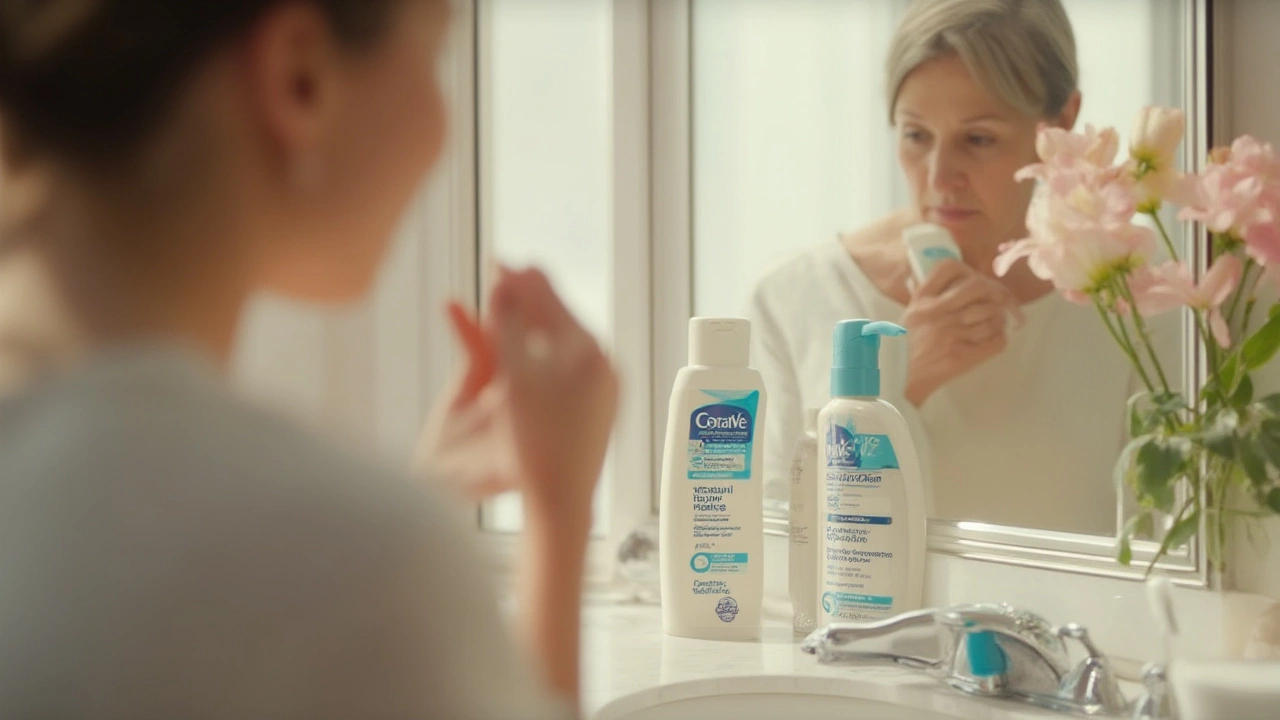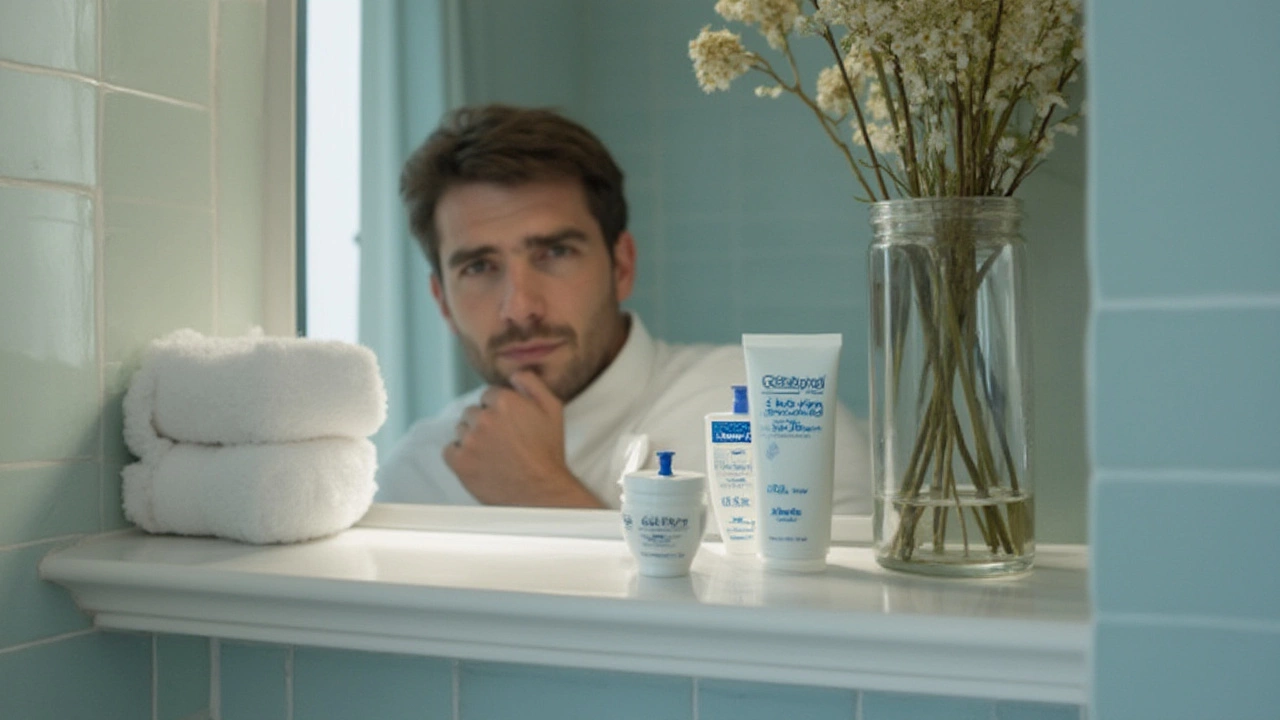
What if everything you thought about gentle skincare brands missed the most crucial details? I remember grabbing that first Cetaphil bottle for my daughter Liora’s dry cheeks, then swinging toward CeraVe because that chunky tub promised ceramides. Suddenly, two drugstore titans lived side-by-side on my bathroom shelf, both fighting for the same spot in my daily routine. Spoiler: The answer isn’t one simple winner. It’s a lot more nuanced—and, yeah, I still share both with my kid. Whether you’re a skincare minimalist or a label-reading ingredient detective, things get real interesting when CeraVe and Cetaphil go head-to-head.
The History Behind the Brands
You might be surprised that Cetaphil’s older than your grandma’s favorite lipstick shade. It first hit shelves in 1947, created by a Texas pharmacist who wanted something even sensitive, eczema-prone patients could use without flaking out—literally. For decades, dermatologists pushed Cetaphil as their “basic but safe” go-to. You’d see that slim white-and-green bottle everywhere from clinics to teenage bathrooms, often prescribed after harsh acne meds or chemical peels. The formula rarely changed; its main claim to fame was being famously boring—no fragrance, minimal suds, nothing flashy, just solid, gentle cleansing.
CeraVe, though, is basically Gen Z compared to Cetaphil. It only launched in 2005, but quickly caused a stir by packing every formula with ceramides. These tiny lipid molecules make up half our skin’s outer barrier. If your face feels rough, tight, or easily irritated, you probably need more ceramides. CeraVe’s bold play? They patented a delivery system so these ceramides stay on your skin longer, repairing and protecting around the clock. They added hyaluronic acid (another skin-plumping favorite) right into the mix. In less than 20 years, CeraVe reshaped drugstore skincare aisles and picked up countless awards and TikTok trends along the way.
Real talk: CeraVe became a derm favorite especially for people fighting eczema, rosacea, and sometimes even cystic acne. Its cleansers and moisturizers grew famous for being not just gentle, but actively strengthening your skin. Cetaphil, long the underdog hero for the super sensitive, found itself sharing the gentle giant crown.
Breaking Down the Ingredients
Here’s the thing—most people don’t actually read the ingredient list. Yet, that’s where CeraVe and Cetaphil set themselves apart. Let’s put the spotlight on what actually goes in your bottle or tub. Cetaphil’s classic Gentle Skin Cleanser is as basic as a white T-shirt. It has water, cetyl alcohol (a softening agent), propylene glycol (locks in moisture), sodium lauryl sulfate (the controversial cleanser, but here in tiny amounts), plus a handful of other skin-conditioning agents. No parabens, no fragrance, minimal risk.
CeraVe, on the other hand, is all about layering on extra benefits. Its Hydrating Cleanser has water, glycerin (big moisture booster), three essential ceramides (NP, AP, EOP), hyaluronic acid, and a gentle surfactant. No fragrance, no harsh sulfates. Their Moisturizing Cream is such a staple that Liora calls it “the snow-cream” thanks to its thick texture and instant effect on winter-dry patches. The biggest difference is in those ceramides—CeraVe literally mimics the building blocks of healthy skin barrier right in your cleanser or moisturizer.
Want the breakdown? Here’s a quick comparison table for their classic cleansers and moisturizers:
| Product | Key Ingredients | Texture | Notable Free-From |
|---|---|---|---|
| Cetaphil Gentle Skin Cleanser | Cetyl alcohol, propylene glycol | Very light, lotion-like | No fragrance, no parabens |
| CeraVe Hydrating Cleanser | Glycerin, 3 ceramides, hyaluronic acid | Creamy, slightly thicker | No fragrance, no sulfates |
| Cetaphil Daily Hydrating Lotion | Glycerin, panthenol | Lightweight, quick-absorbing | No fragrance, hypoallergenic |
| CeraVe Moisturizing Cream | 3 ceramides, hyaluronic acid, petrolatum | Dense, rich | No fragrance, non-comedogenic |
If your skin is bone-dry, the CeraVe vs Cetaphil showdown comes down to those ceramides. They help your barrier recover faster, especially after harsh acne routines or retinol. If fragrance sensitivity or a history of allergies is your big worry, Cetaphil nails the super-simple formula. Tip: Always patch test on your forearm if you tend to react to new products—my kid learned this after one surprise rash from a scented face cream!

Fan Favorites: Real Results and User Stories
I’ve scrolled forums, read parenting groups, and swapped voice notes with skincare friends—people get fiercely loyal to their pick. Around 80% of dermatologists (according to surveys in Allure and Dermstore polls) say they regularly recommend either CeraVe or Cetaphil as first-line choices for eczema, acne, and sensitive skin. The internet loves a CeraVe Hydrating Cleanser glow-up photo: users show flakey winter faces turning plump and soft, sometimes within a week. Teens recovering from benzoyl peroxide dryness post about CeraVe’s Moisturizing Cream like it’s magic. TikTok trends (an average of 400 million views on “CeraVe routine”) definitely pushed the hype sky-high, but the love runs deep. People rave about how quickly their redness disappeared or how their cheeks stopped feeling like sandpaper.
Cetaphil fans, on the other hand, often come in two camps: the super-sensitive, and those with a long family tradition. My aunt wouldn’t touch anything but her Cetaphil Gentle Cleanser for thirty years. Her face is calm, clear, never gets breakouts, and she claims fancier formulas make her itchy. Parents with eczema-prone toddlers trust Cetaphil’s lack of fuss: no stinging, no tears, and you can use it on both face and body. In fact, Cetaphil has expanded its line over time, so you’ll find versions dedicated to oily skin, redness-prone types, and even baby formulas now.
It’s not all rave reviews. Some complain that Cetaphil feels too slippery, doesn’t remove waterproof makeup, or can leave a film if you use too much. Meanwhile, a chunk of oily-skinned users say CeraVe’s Hydrating Cleanser is too rich or can break them out—especially in hot, humid climates. If you’re an athlete or spend summers sweating outdoors, you might need to alternate a foaming cleanser (both brands make oil-control or foamy versions) to cut through sunscreen or sweat. It’s honestly about matching your skin type, the climate, and your makeup needs—not hoping for a universal “one and done.”
Which Works Better for Each Skin Type?
The match-up comes down to two big questions: what’s your skin type, and what do you want from your skincare? For dry and sensitive skin, both lines work well—but CeraVe’s ceramide-packed formulas seem to have a faster effect on skin relief, especially if you’re coming off cravings like retinol or have barrier damage. The National Eczema Association actually gives CeraVe’s Moisturizing Cream a stamp of approval for eczema. Cetaphil holds its own on gentleness: its stripped-back formulas rarely irritate, and it’s a savior during allergy season when everything sets you off.
For oily or acne-prone skin, the classic Cetaphil Gentle Skin Cleanser is really lightweight and won’t clog pores—it’s also a common choice for kids hitting puberty, since it won’t sting or cause a greasy buildup. But, CeraVe’s Foaming Cleanser for normal to oily skin includes niacinamide (great for calming acne and redness) and ceramides that keep your face from getting scratchy after deep cleansing. If you’re worried about makeup, heavy sunscreen, or city smog, go for a foaming cleanser from either brand—and double cleanse if you need.
Got combination skin or a mix of needs in one household? Honestly, it’s totally normal to see both bottles in the bathroom—one for gentle morning cleansing (friendly for teens or dry cheeks), another for post-workout degreasing. Liora, for example, uses Cetaphil after swimming because it’s fast and doesn’t sting. I stash a tube of CeraVe Moisturizing Cream for winter days where my hands crack after repeated washing.
- Dry and sensitive skin: CeraVe Hydrating Cleanser, CeraVe Moisturizing Cream, or Cetaphil Gentle Cleanser (patch test if ultra-sensitive)
- Oily or acne-prone: Cetaphil Gentle Cleanser or CeraVe Foaming Cleanser; add a lightweight oil-free moisturizer
- Makeup wearers: Double cleanse, use a foaming formula, or gently remove makeup with micellar water first
- Kids, eczema, allergy-prone: Cetaphil Baby or CeraVe Baby lines are both fragrance-free and extra gentle
Don’t skip SPF just because your skin feels smoother. Both brands offer SPF moisturizers, and dermatologists still see sun damage as the #1 cause of premature aging and flare-ups. Even the best gentle cleanser won’t undo a summer’s worth of forgetting sunscreen.

Tips, Myths, and What to Watch Out For
This is where things get juicy. Big myths still swirl around these brands. A major one? “Simple=better.” But simple formulas aren’t always powerful enough if your barrier needs urgent help. Also, don’t believe the rumors that Cetaphil’s classic cleanser “does nothing”—it actually cleans well, especially for mild pollutants and sweat, but you won’t get that squeaky-clean film. Want real waterproof mascara gone? Use a gentle micellar water before your regular cleanser from either brand. Some claim parabens in older formulas triggered acne; actually, both brands have shifted away from parabens in their major US and UK lines in the last few years.
Another overlooked fact: Each brand now makes multiple formulas tailored to acne, oil control, or even redness. Too many people grab the classic bottle, then complain when it doesn’t fit their needs. You absolutely have to check the label before you blame the brand for breakouts or dryness. Need to layer up moisture at night? CeraVe Moisturizing Cream’s occlusive finish is brilliant in winter. Want a pump-and-go lightweight solution for humid climates? Cetaphil’s new Daily Hydrating Lotion is practically invisible and won’t pill under sunscreen.
Here’s a trick: combine both. You might find Cetaphil’s Gentle Skin Cleanser works for your quick morning rinse, especially if you have sensitive eyes, then finish with CeraVe’s heavier cream for nighttime repair. Many dermatologists and estheticians now recommend customization—swap between the two, use lighter textures in summer, and richer creams as the seasons change. If you’re building a basic kid routine or nailing down a routine for sensitive skin, either brand is probably safer than any heavily fragranced or high-acid formula. Just stay alert for outdated bottles—companies do update formulas, so always check for the “new and improved” sticker if you’re buying online or at discount stores.
- Test new products on your wrist or neck before full-face use, especially for kids.
- Never trust a viral trend on its own—read the ingredient list and listen to your own skin first.
- SPF every single day, even when using gentle cleansers or moisturizers.
- If it stings, burns, or causes sudden breakouts, stop use and consult a professional. Sometimes skin just reacts to a change.
- Store creams in a cool area to keep them from separating or spoiling—especially in summer heatwaves.
Bottom line? CeraVe and Cetaphil both “win”—depending on your skin’s needs, time of year, and what makes you feel good about your routine. Liora and I don’t pick sides: we make space for whatever keeps our skin calm, happy, and ready for another day taking on the world—one gentle cleanse at a time.